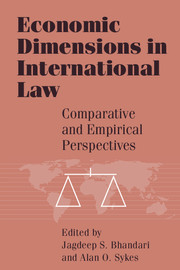Book contents
- Frontmatter
- Contents
- Preface
- Introduction: Economics and international law
- 1 The economics of the most favored nation clause
- 2 The economics of “injury” in antidumping and countervailing duty cases
- 3 The economics of “injury” in antidumping and countervailing duty cases: A reply to Professor Sykes
- 4 Innovations in support of the unitary injury test in U.S. unfair trade cases
- 5 The free trade–fair trade debate: Trade, labor, and the environment
- 6 International conflict and coordination in environmental policies
- 7 Market modernization of law: Economic development through decentralized law
- 8 Toward a positive theory of privatization: Lessons from Soviet-type economies
- 9 New stories on exchange rate policies in transition
- 10 Is deposit insurance inevitable? – lessons from Argentina
- 11 The market for migrants
- 12 The interplay of liquidation and reorganization in the bankruptcy systems of Canada and the United States: The role of screens, gatekeepers, and guillotines
- 13 International political economy approaches to international institutions
- 14 The trade effects of domestic antitrust enforcement
- 15 The Hartford Insurance Company case: Antitrust in the global economy – welfare effects and sovereignty
- 16 Recognition of foreign judgments as a trade law issue: The economics of private international law
- 17 Externalities and extraterritoriality: The law and economics of prescriptive jurisdiction
- Index
4 - Innovations in support of the unitary injury test in U.S. unfair trade cases
Published online by Cambridge University Press: 05 December 2011
- Frontmatter
- Contents
- Preface
- Introduction: Economics and international law
- 1 The economics of the most favored nation clause
- 2 The economics of “injury” in antidumping and countervailing duty cases
- 3 The economics of “injury” in antidumping and countervailing duty cases: A reply to Professor Sykes
- 4 Innovations in support of the unitary injury test in U.S. unfair trade cases
- 5 The free trade–fair trade debate: Trade, labor, and the environment
- 6 International conflict and coordination in environmental policies
- 7 Market modernization of law: Economic development through decentralized law
- 8 Toward a positive theory of privatization: Lessons from Soviet-type economies
- 9 New stories on exchange rate policies in transition
- 10 Is deposit insurance inevitable? – lessons from Argentina
- 11 The market for migrants
- 12 The interplay of liquidation and reorganization in the bankruptcy systems of Canada and the United States: The role of screens, gatekeepers, and guillotines
- 13 International political economy approaches to international institutions
- 14 The trade effects of domestic antitrust enforcement
- 15 The Hartford Insurance Company case: Antitrust in the global economy – welfare effects and sovereignty
- 16 Recognition of foreign judgments as a trade law issue: The economics of private international law
- 17 Externalities and extraterritoriality: The law and economics of prescriptive jurisdiction
- Index
Summary
Introduction
Unfair trade allegations fall into two categories: dumping and countervailable subsidies. The right of GATT signatory nations to collect antidumping duties and countervailing duties intended to “remedy” (i.e., offset the trade effects of) foreign unfair practices is set out in Article VI of the GATT, together with the Antidumping Code and the Subsidies Code.
Dumping is the practice of selling in an export market at prices that are below “fair value” (i.e., those charged in the producing firm's home market) or at prices that are less than production cost. Countervailable subsidies arise when export subsidies, or domestic production subsidies, encourage an expansion of exports.
Generally, antidumping (AD) or countervailable subsidy (CVD) investigations are initiated following receipt by the administering government authorities of a petition prepared by a domestic industry. The petition must contain the appropriate allegations and assertions of fact. Before the authorities may issue remedial orders, two findings must be reached:
First, the alleged unfair practice, or others identified by the authorities, must be occurring, and the magnitude of the dumping margin or subsidy rate must not be de minimus.
Second, the practice must be causing material injury to a domestic industry producing the product or products that are “like” the subject imports. The domestic industry must be determined to be “materially injured by reason of” the imports that are subject to investigation.
- Type
- Chapter
- Information
- Economic Dimensions in International LawComparative and Empirical Perspectives, pp. 166 - 185Publisher: Cambridge University PressPrint publication year: 1998



